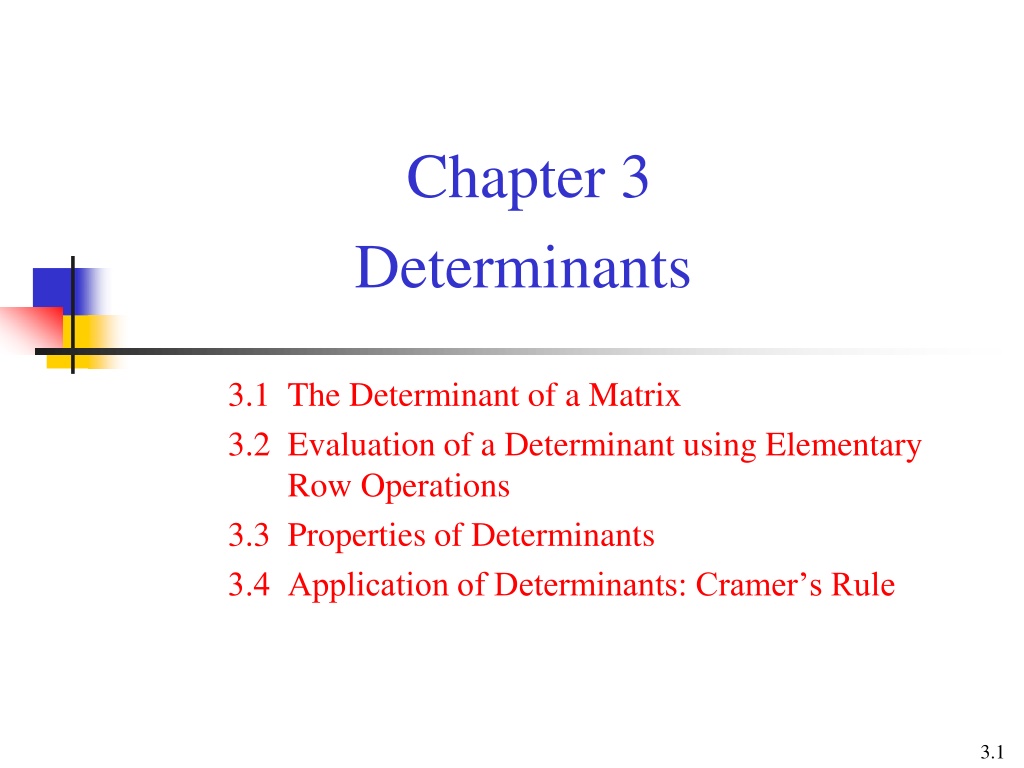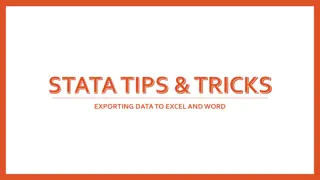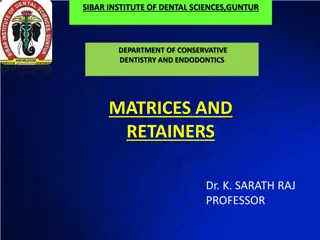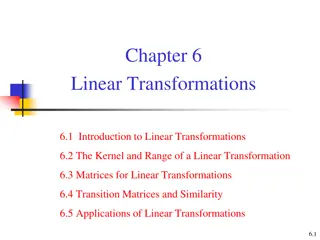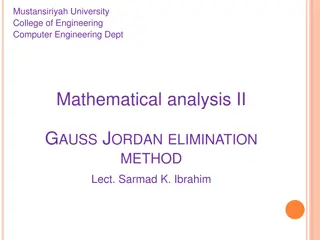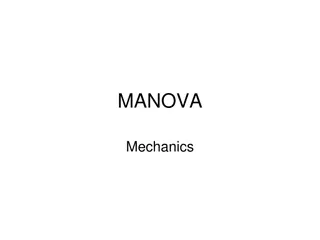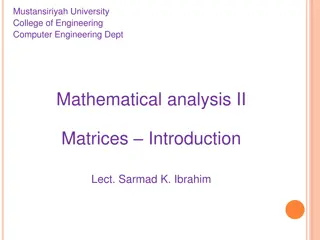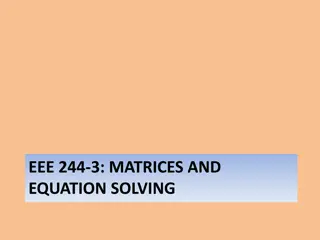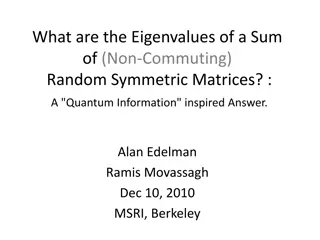Determinants in Matrices
Concept of determinants in matrices, this chapter delves into the significance of determinants in reflecting matrix characteristics and facilitating matrix comparisons. Learn about the evaluation of determinants using elementary row operations, properties of determinants, and the application of determinants in Cramer's rule, providing essential insights into square matrices. Discover the historical origins of determinants and grasp their role in solving linear systems. Explore examples and the calculation of determinants for 2x2 matrices.
Download Presentation

Please find below an Image/Link to download the presentation.
The content on the website is provided AS IS for your information and personal use only. It may not be sold, licensed, or shared on other websites without obtaining consent from the author.If you encounter any issues during the download, it is possible that the publisher has removed the file from their server.
You are allowed to download the files provided on this website for personal or commercial use, subject to the condition that they are used lawfully. All files are the property of their respective owners.
The content on the website is provided AS IS for your information and personal use only. It may not be sold, licensed, or shared on other websites without obtaining consent from the author.
E N D
Presentation Transcript
Chapter 3 Determinants 3.1 The Determinant of a Matrix 3.2 Evaluation of a Determinant using Elementary Row Operations 3.3 Properties of Determinants 3.4 Application of Determinants: Cramer s Rule 3.1
The determinant is NOT a matrix operation The determinant is a kind of information extracted from a square matrix to reflect some characteristics of that square matrix For example, this chapter will discuss that matrices with a zero determinant are with very different characteristics from those with non-zero determinants The motives to calculate determinants are to identify the characteristics of matrices and thus facilitate the comparison between matrices since it is impossible to investigate or compare matrices entry by entry The similar idea is to compare groups of numbers through the calculation of averages and standard deviations Not only the determinant but also the eigenvalues and eigenvectors are the information that can be used to identify the characteristics of square matrices 3.2
3.1 The Determinant of a Matrix The determinant ( ) of a 2 2 matrix: a a 11 12 = A a a 21 22 = = det( ) | | A A a a a a 11 22 21 12 Note: 1. For every SQUARE matrix, there is a real number associated with this matrix and called its determinant 2. It is common practice to omit the matrix brackets a a a a 11 12 = 11 12 a a a a 21 22 21 22 3.3
Historically speaking, the use of determinants arose from the recognition of special patterns that occur in the solutions of linear systems: + + = = 11 1 a x a x 12 2 a x a x b b 1 21 1 22 2 2 1 22 ba a a 2 12 b a a a 2 11 b a a a 1 21 ba a a = = and x x 1 2 11 22 21 12 11 22 21 12 Note: 1. x1and x2have the same denominator, and this quantity is called the determinant of the coefficient matrix A 2. There is a unique solution if a11a22 a21a12= |A| 0 3.4
Ex. 1: The determinant of a matrix of order 2 2 3 = ( 1 ) 3 = + = ) 2 ( 2 4 3 7 1 2 2 1 = ) 1 ( 4 = = ) 2 ( 2 4 4 0 4 2 0 / 3 2 = / 3 ( 2 = = ) 4 ( 0 ) 2 0 3 3 2 4 Note: The determinant of a matrix can be positive, zero, or negative 3.5
Minor () of the entry aij: the determinant of the matrix obtained by deleting the i-th row and j-th column of A a a a a a ) 1 ) 1 + 11 12 ( 1 ( 1 1 j j n a a a a 1 ) 1 ) 1 ) 1 + ) 1 ( ( 1 )( ( 1 )( ( i i j i j i n = M Mijis a real number ij a a a a 1 ) 1 + + ) 1 + ) 1 + ) 1 + ( ( 1 )( ( 1 )( ( i i j i j i n a a a a ) 1 ) 1 + 1 ( ( n n j n j nn Cofactor ( ) of aij: + = i j ( ) 1 C M Cijis also a real number ij ij 3.6
Ex: a a a 11 12 13 = A a a a 21 22 23 a a a 31 32 33 a a a a 12 13 = 11 13 = M M 21 22 a a a a 32 33 31 33 + + = ) 1 = = ) 1 = 2 1 2 2 ( C M M ( C M M 21 21 21 22 22 22 + + + Notes: Sign pattern for cofactors. Odd positions (where i+j is odd) have negative signs, and even positions (where i+j is even) have positive signs. (Positive and negative signs appear alternately at neighboring positions.) + + + + + + + + + + 3.7
Theorem 3.1: Expansion by cofactors () Let A be a square matrix of order n, then the determinant of A is given by n = = = + + + (a) det( ) | A | A a C a C a C a C 1 1 2 2 ij ij i i i i in in = 1 j (cofactor expansion along the i-th row, i=1, 2, , n) or n = = = + + + (b) det( ) | A | A a C a C a C a C 1 1 2 2 ij ij j j j j nj nj = 1 i (cofactor expansion along the j-th column, j=1, 2, , n) The determinant can be derived by performing the cofactor expansion along any row or column of the examined matrix 3.8
Ex: The determinant of a square matrix of order 3 a a a 11 12 13 = A a a a 21 22 23 a a a 31 32 33 = = = = = = + + + + + + + det( ) (first row expansion) (second row expansion) (third row expansion) (first column expansion) (second column expansion) (third column expansion) A a C a C a C a C a C a C a C a C a C a C a C a C a C + + + + 11 11 12 12 13 a C a C a C a a C + 13 21 21 22 22 23 23 31 31 32 32 33 33 11 11 21 21 31 31 C 12 12 22 22 3 2 32 13 13 23 23 33 33 3.9
Ex 3: The determinant of a square matrix of order 3 0 2 1 3 1 2 4 0 1 Sol: = = det( ) ? A A 3 2 1 2 + + = ) 1 = 1 1 = ) 1 = ) 5 = 1 2 ( 1 C ( ( 1 )( 5 C 11 12 0 1 4 1 3 1 + = ) 1 = 1 3 ( 4 C 13 4 0 = + + det( ) A a C a C a C 11 11 12 12 13 13 = ) 1 2 ( + + 0 ( )( ) 5 )( 1 ( ) 4 )( = 14 3.10
Alternative way to calculate the determinant of a square matrix of order 3: Subtract these three products a a a a a a a a a a a a a a 11 12 13 11 12 11 12 13 a a a a a = A 21 22 23 21 22 21 22 23 a a a a a 31 32 33 31 32 31 32 33 Add these three products = = + + det( ) | | A A a a a a a a a a a a a a 11 22 33 12 23 31 13 21 32 31 22 13 a a a a a a 32 23 11 33 21 12 3.11
Ex: Recalculate the determinant of the square matrix A in Ex 3 4 0 6 0 3 4 2 1 0 3 4 2 = 1 2 0 A 1 1 0 0 16 0 = | 0 16 0 ( 4) 0 6 14 = + + = det( ) | A A This method is only valid for matrices with the order of 3 3.12
Ex 4: The determinant of a square matrix of order 4 1 2 3 0 0 1 1 0 2 = = A det( ) ? A 2 0 3 3 4 0 2 3.13
Sol: = = 0 ( + 0 ( + 0 ( + det( ) 3 ( )( ) )( ) )( ) )( ) A C C C C 13 23 33 43 3C 13 1 1 2 + = ) 1 1 3 ( 3 0 2 3 3 4 2 1 2 1 2 1 1 + + + = ) 1 2 ( + ) 1 3 ( + ) 1 2 1 2 2 2 3 3 0 ( )( )( )( 4 2 3 2 3 4 = 2 ( + ) 4 3 ( + ) 7 3 0 )( 1 )( )( 1 )( = 3 ( )( 13 ) = 39 By comparing Ex 4 with Ex 3, it is apparent that the computational effort for the determinant of 4 4 matrices is much higher than that of 3 3 matrices. In the next section, we will learn a more efficient way to calculate the determinant 3.14
Upper triangular matrix (): All entries below the main diagonal are zeros Lower triangular matrix ( ): All entries above the main diagonal are zeros Diagonal matrix ( ): All entries above and below the main diagonal are zeros Ex: 0 0 a a a 0 0 a a 11 0 12 13 11 0 11 0 0 a a a a a 22 0 23 22 0 21 22 0 0 a a a a a 31 32 33 33 33 diagonal lower triangular upper triangular 3.15
Theorem 3.2: (Determinant of a Triangular Matrix) If A is an n n triangular matrix (upper triangular, lower triangular, or diagonal), then its determinant is the product of the entries on the main diagonal. That is = = det( ) | | A A a a a a 11 22 33 nn I = Based on Theorem 3.2, it is straightforward to obtain that On the next slide, I only take the case of upper triangular matrices for example to prove Theorem 3.2. It is straightforward to apply the following proof for the cases of lower triangular and diagonal matrices det( ) 1 3.16
Pf: by Mathematical Induction () Suppose that the theorem is true for any upper triangular matrix U of order ? 1, i.e., = | | U 11 22 33 a a a a 1)( ( 1) n n Then consider the determinant of an upper triangular matrix A of order n by the cofactor expansion across the n-th row | 0 = + + + + = ( 1) = 2 n | 0 0 A C C C a C a M a M 1 2 ( 1) n n n n nn nn nn nn nn nn Since Mnnis the determinant of a (n 1) (n 1) upper triangular matrix by deleting the n-th row and n-th column of A, we can apply the induction assumption to write = = = | | ( ) A a M a 11 22 a a a 11 22 a a a a 1)( 1)( ( 1) ( 1) nn nn nn n n n n nn 3.17
Ex 6: Find the determinants of the following triangular matrices 1 0 0 0 0 2 0 0 0 0 3 0 0 0 4 2 0 0 = B 0 0 2 0 0 = (b) A (a) 5 6 1 0 0 0 0 4 0 1 5 3 3 0 0 0 0 2 Sol: |A| = (2)( 2)(1)(3) = 12 (a) |B| = ( 1)(3)(2)(4)( 2) = 48 (b) 3.18
Keywords in Section 3.1: determinant: minor: cofactor: expansion by cofactors: upper triangular matrix: lower triangular matrix: diagonal matrix: 3.19
3.2 Evaluation of a Determinant Using Elementary Row Operations The computational effort to calculate the determinant of a square matrix with a large number of n is unacceptable. In this section, I will show how to reduce the computational effort by using elementary operations Theorem 3.3: Elementary row operations and determinants Let A and B be square matrices = = (a) ( ) A det( ) det( ) B I B A (by mathematical induction (( )) , i j = = ( ) k i (b) ( ) A det( ) det( ) B M B k A (straightforward) = = ( ) , i j k (c) ( ) A det( ) det( ) B A B A (by combining Thm. 3.4 and 3.5) Notes: The above three properties remains valid if elementary column operations are performed to derive column-equivalent matrices (These results will be used in Ex 5 on Slide 3.25) 3.20
Ex: 1 0 1 2 1 2 3 4 1 = = det( ) 2 A A 4 0 1 8 12 1 2 = (4) 1 ) = ( ) 4det( ) A M A A 1 = = 4 1 det( ) 8 A A 1 = = det( (4)( 2) 8 A 1 1 0 1 1 1 2 2 4 3 1 = ( ) A = A I 2 1, 2 ) = = det( ) 2 A A 2 = = 2 det( det( ) ( 2) 2 A A 2 1 2 3 = ( 2) 1,2 ) = ( ) det( ) A A A 3 = = 2 3 2 det( ) 2 A A 3 = 3 det( 2 A A 3 1 2 1 3.21
Row reduction method to evaluate the determinant 1. A row-echelon form of a square matrix is either an upper triangular matrix or a matrix with zero rows 2. It is easy to calculate the determinant of an upper triangular matrix (by Theorem 3.2) or a matrix with zero rows (det = 0) Ex: Evaluation a determinant using elementary row operations 2 3 10 = = det( ) ? A 1 2 2 A 0 1 3 Sol: Notes: 2 1 0 3 10 2 1 1 2 0 2 2 = det( ) det( ) det( = A A 1A A 1 1,2 I = det( ) 2 3 3 10 1 A det( ) ) A A 1 3 3.22
1 0 0 2 2 1 2 1 1 2 2 3 1 1 7 2 A 3 A ( 2 ) ( 2) 1,2 A M 7 14 ( 1) ( ) 0 (1/7) 1 3 0 = 1 2 1 0 2 2 1 4 A A ( 1) 2,3 7( 1) = 7 0 7 0 Notes: = det( ) det( 1 7 det( ) A A 2 1 1 = = det( ) det( ) det( ) det( ) A A A A 3 2 2 3 (1/7) = det( ) ) A A 4 3 3.23
Comparison between the number of required operations for the two kinds of methods to calculate the determinant Cofactor Expansion Row Reduction Order n Additions Multiplications Multiplications Additions 3 5 9 5 10 5 119 205 30 45 10 3,628,799 6,235,300 285 339 When evaluating a determinant by hand, you can sometimes save steps by integrating this two kinds of methods (see Examples 5 and 6 on the next three slides) 3.24
Ex 5: Evaluating a determinant using column reduction and cofactor expansion 3 5 2 = 6 2 4 1 A 3 0 Sol: 3 5 2 3 5 4 (2) 1,3 = AC = det( ) 2 4 1 2 4 3 0 A 3 0 6 3 0 5 4 3 1 + ( 3)( 1) = ( 3)(1)( 1) = = 3 4 3 ( ) k ( ) , i j k is the counterpart column operation to the row operation , i j AC A 3.25
Ex 6: Evaluating a determinant using both row and column reductions and cofactor expansion = 2 1 3 2 0 1 3 2 2 1 3 2 1 A 1 0 1 2 3 4 3 1 1 3 2 0 Sol: 2 2 1 3 1 0 1 0 1 1 1 3 1 2 2 3 3 2 2 1 3 3 0 2 2 1 0 1 0 3 0 1 1 3 1 2 5 0 3 2 2 1 3 4 1 (1) 2,4 ( 1) 2,5 A = A = det( ) A 4 2 6 0 0 2 1 1 3 1 3 2 1 2 5 0 3 2 2 + = (1)( 1) 6 0 4 1 3.26
8 1 3 2 8 1 3 0 0 5 ( 3) 4,1 = (1) 2,1 8 1 2 5 0 3 AC A 4 4 + = (1)( 1) 8 1 2 = 8 5 6 1 2 5 13 0 6 0 4 13 13 6 1 8 1 1 3 + = 5( 1) 13 5 = (5)( 27) 135 = 3.27
Theorem 3.4: Conditions that yield a zero determinant If A is a square matrix and any of the following conditions is true, then det(A) = 0 (a) An entire row (or an entire column) consists of zeros (Perform the cofactor expansion along the zero row or column) (b) Two rows (or two columns) are equal (c) One row (or column) is a multiple of another row (or column) (For (b) and (c), based on the mathematical induction, perform the cofactor expansion along any row or column other than these two rows or columns) Notes: For conditions (b) or (c), you can also use elementary row or column operations to create an entire row or column of zeros and obtain the results by Theorem 3.3 Thus, we can conclude that a square matrix has a determinant of zero if and only if it is row- (or column-) equivalent to a matrix that has at least one row (or column) consisting entirely of zeros 3.28
Ex: 1 2 3 1 4 0 1 1 1 = = = 0 0 0 0 2 5 0 0 2 2 2 0 4 5 6 3 6 0 4 5 6 1 4 2 1 2 3 1 8 4 = = = 1 5 2 0 4 5 6 0 2 10 5 0 1 6 2 2 4 6 3 12 6 3.29
3.3 Properties of Determinants Theorem 3.5: Determinant of a matrix product det(AB) = det(A) det(B) (Verified by Ex 1 on the next slide) Notes: (1) = det( ) det( )det( ) det( ) A A A A A A (by using Thm. 3.5 iteratively) 1 2 1 2 n n = = = = = = det( det( det( ) det( det( det( = )det( ) and det( )det( ) and det( )det( ) and det( A ) A A det( ) det( ) det( ) det( det( det( ) 1 k E A E E E E E A E A A E , , , , i j i j i j E E i j E = ( ) k i k i j ( ) k i k i j ( ) k i k i j ( ) k i (2) ) ) ) ) ) = A A A k A ( ) , ( ) , ( ) , ( ) , i j k ) 1 A E + + det( ) det( ) det( ) A B A B (3) a a a a a a a a a a b a a b a a b a a a a 11 12 13 11 12 13 11 + 12 + 13 + = + a b a b a b (4) 21 22 23 21 22 23 21 21 22 22 23 23 a a a 31 32 33 31 32 33 31 32 33 (There is an example to verify this property on Slide 3.33) (Note that this property is also valid for any rows or columns other than the second row) 3.30
Ex 1: The determinant of a matrix product 1 2 2 2 0 1 = = 1 0 3 2 0 1 2 A B 1 0 1 3 2 Find |A|, |B|, and |AB| Sol: 2 0 1 1 2 2 = = = = | | 0 1 2 11 B | | 0 3 2 7 A 3 1 2 1 0 1 3.31
1 2 2 2 0 1 8 4 1 = 1 = 1 0 3 2 0 1 2 6 1 10 AB 1 0 1 3 2 5 1 8 6 5 4 1 10 1 = = | | 1 77 AB 1 Check: |AB| = |A| |B| 3.32
Ex: 1 0 1 2 2 2 1 1 2 2 2 1 1 1 1 2 2 0 1 ? = = + = + 3 0 1 1 0 2 0 A B C 1 Pf: 2 2 1 1 2 1 1 1 1 2 2 1 + 2 2 + 2 3 + | 0( 1) = + 3( 1) + 2( 1) | A 0 0 2 2 1 1 2 1 1 1 1 2 2 1 + 2 2 + 2 3 + = 1( 1) + + 2( 1) | | 1( 1) B 0 0 2 2 1 1 2 1 1 1 1 2 2 1 + 2 2 + 2 3 + | 1( 1) = + 2( 1) + 0( 1) | C 0 0 3.33
Theorem 3.6: Determinant of a scalar multiple of a matrix If A is an n n matrix and c is a scalar, then det(cA) = cndet(A) = = ( ) k i (can be proven by repeatedly use the fact that ) if ( ) A B M B k A Ex 2: 10 30 20 20 0 30 10 40 50 , if 3 1 2 4 5 1 = = 0 5, find | | A A 2 3 Sol: 1 2 4 1 2 4 A = = = 103 3 0 5 1000 ( ) 5 )( 5000 = 10 3 0 5 A 2 3 1 2 3 1 3.34
Theorem 3.7: (Determinant of an invertible matrix) A square matrix A is invertible (nonsingular) if and only if det(A) 0 Pf: If A is invertible, then AA 1= I. By Theorem 3.5, we can have |A||A 1| = |I|. Since |I| = 1, neither |A| nor |A 1| is zero Suppose |A| is nonzero. It is aimed to prove A is invertible. By the Gauss-Jordan elimination, we can always find a matrix B, in reduced row-echelon form, that is row- equivalent to A 1. Either B has at least one row with entire zeros, then |B| = 0 and thus |A| = 0 since |Ek| |E2||E1||A| = |B|. 2. Or B = I, then A is row-equivalent to I, and by Theorem 2.15 (Slide 2.59), it can be concluded that A is invertible ( ) ( ) 3.35
Ex 3: Classifying square matrices as singular or nonsingular 1 0 2 1 1 0 2 1 = 3 2 B = 3 2 A 3 2 1 3 2 1 Sol: = 0 A A has no inverse (it is singular) = B has inverse (it is nonsingular) 12 0 B 3.36
Theorem 3.8: Determinant of an inverse matrix 1 = 1 , If is invertible then det( A ) A det( ) A = = 1 1 (Since , then 1) AA I A A Theorem 3.9: Determinant of a transpose = T If is a square matrix, then det( ) det( ) A A A (Based on the mathematical induction, compare the cofactor expansion along a row of A and the cofactor expansion along the corresponding column of AT) Ex 4: 1 0 3 1= = ? T A (a) ? A (b) = 1 0 1 2 A 2 0 Sol: 1 A 1 1 0 3 = = 1 A 4 4 = = | | 0 1 2 4 A = A = AT 2 1 0 3.37
The similarity between the noninvertible matrix and the real number 0 Matrix A Real number c Invertible det( ) 0 0 A c 1 1 c = 1 1 1 1 exists and det( ) exists and = A A c c det( ) A = Noninvertible = det( ) 0 A 0 c 1 1 does not exist A does not exist 1 1 = =0 c c 1 1 0 1 = = 1 c det( ) A det( ) A 3.38
Equivalent conditions for a nonsingular matrix: If A is an n n matrix, then the following statements are equivalent (1) A is invertible (2) Ax = b has a unique solution for every n 1 matrix b (Thm. 2.11) (3) Ax = 0 has only the trivial solution (Thm. 2.11) (4) A is row-equivalent to In (Thm. 2.14) (5) A can be written as the product of elementary matrices (Thm. 2.14) (6) det(A) 0 (Thm. 3.7) The statements (1)-(5) are collected in Theorem 2.15, and the statement (6) is from Theorem 3.7 3.39
Ex 5: Which of the following system has a unique solution? (a) = 2 1 x x 2 3 + = 3 2 4 x x x 1 2 3 + = 3 2 4 x x x 1 2 3 (b) = 2 1 x x 2 3 + = 3 2 4 x x x 1 2 3 + + = 3 2 4 x x x 1 2 3 3.40
Sol: = (a) x b (the coefficient matrix is the matrix in Ex 3) 0 (from Ex 3) A = This system does not have a unique solution A A = x b (b) (the coefficient matrix is the matrix in Ex 3) 12 0 (from Ex 3) B = This system has a unique solution B B 3.41
3.4 Applications of Determinants Matrix of cofactors ( ) of A: C C C 11 12 1 n C C C C + = i j ( ) 1 C M 21 22 2 n = ij ij ij C C C 1 2 n n nn (The definitions of cofactor Cijand minor Mijof aijcan be reviewed on Slide 3.6) Adjoint matrix ( ) of A: C C C C C C 11 21 1 n T 12 22 2 n = = adj( ) A C ij C C C 1 2 n n nn 3.42
Theorem 3.10: The inverse of a matrix expressed by its adjoint matrix 1 = If A is an n n invertible matrix, then 1 adj( ) A A det( ) A Pf: Consider the product A[adj(A)] a a a 11 12 1 n C C C C C C det( ) 0 0 0 0 A 11 1 1 j n det( ) A 12 2 2 j n = = a a a 1 2 i i in C C C 0 0 det( ) A 1 n jn nn a a a 1 2 n n nn The entry at the position (i, j) of A[adj(A)] = det( ) 0 if if A i i j j + + + = a C a C a C 1 1 2 2 i j i j in jn 3.43
Consider a matrix B similar to matrix A except that the j-th row is replaced by the i-th row of matrix A a a a 11 12 1 n a a a Since there are two identical rows in B, according to Theorem 3.4, det(B) should be zero 1 2 i i in = = det( ) 0 B a a a 1 2 i i in a a a 1 2 n n nn Perform the cofactor expansion along the j-th row of matrix B = + + + = det( ) 0 B a C a C a C 1 1 2 2 i j i j in jn (Note that Cj1, Cj2, , and Cjnare still the cofactors for the entries of the j-th row) A-1 1 = = [adj( )] A det( ) adj( ) A A I A A I det( ) A 3.44
Ex: For any 22 matrix, its inverse can be calculated as follows a b = = det( ) , A ad bc A c d C C C C d b 11 21 = = adj( ) A c a 12 22 d b 1 1 = = 1 adj( ) A A ( ) A ad bc c a det 3.45
Ex 2: 0 1 3 2 (a) Find the adjoint matrix of A = 2 1 A (b) Use the adjoint matrix of A to find A 1 1 0 2 Sol: + = i j ( ) 1 C M ij ij 0 1 2 0 1 1 2 1 = + = C = = 2, C = + = 1, 4, C 13 12 0 11 2 0 2 1 3 1 1 2 3 0 2 = = = + = 3, C 0, C C = = 6, 23 22 0 1 2 21 2 1 3 1 2 0 3 2 1 = + = 2. C = = 1, C C = + = 7, 33 0 2 32 1 31 2 3.46
cofactor matrix of A = 7 adjoint matrix of A 4 1 2 4 1 2 6 0 3 7 1 2 C T 6 0 3 = = adj( ) A C ij ij 1 2 inverse matrix of A The computational effort of this method to derive the inverse of a matrix is higher than that of the G.-J. E. (especially to compute the cofactor matrix for a higher-order square matrix) However, for computers, it is easier to implement this method than the G.-J. E. since it is not necessary to judge which row operation should be used and the only thing needed to do is to calculate determinants of matrices 1 ( ) A = = 1 adj( ) A A (det 3) ( ) A det 4 6 7 2 7 4 3 3 = = 1 0 1 0 1 1 1 3 3 3 2 3 2 1 2 2 3 3 1 = AA I Check: 3.47
Theorem 3.11: Cramers Rule + + + + + + = = 11 1 a x a x a x a x a x a x b b 12 2 1 1 n n A(i)represents the i-th column vector in A 21 1 22 2 2 2 n n = x b A + + + = 1 1 n a x a x a x b b b 2 2 n nn n n x x 1 1 2, 2 = = b x = = (1) (2) ( ) n where , A a A A A ij n n b x n n Suppose this system has a unique solution, i.e., a a A = a a a a 11 12 1 n 21 22 2 n det( ) 0 a a a 1 2 n n nn 3.48
+ = (1) (2) ( 1) ( 1) ( ) n j j b By defining j A A A A A A a a a a b b a a a a + 11 1( 1) 1 1( 1) 1 j j n + 21 2( 1) 2 2( 1) 2 j j n = a a b a a + 1 ( 1) ( 1) n n j n n j nn = + + + (i.e., det( ) ) A bC b C b C 1 1 2 2 j j j n nj det( det( ) ), A A j = = 1,2, , x j n j 3.49
Pf: A Ax = b (det( ) 0) 1 = = 1 b x b adj( ) A A (according to Thm. 3.10) det( ) A C C C C C C b b 11 21 1 1 n 1 12 22 2 2 n = det( ) A C C C b 1 2 n n nn n + + + + + + bC bC b C b C b C b C 1 11 2 21 1 n n 1 1 12 2 22 2 n n = det( ) A + + + bC b C b C 1 1 2 2 n n n nn 3.50
